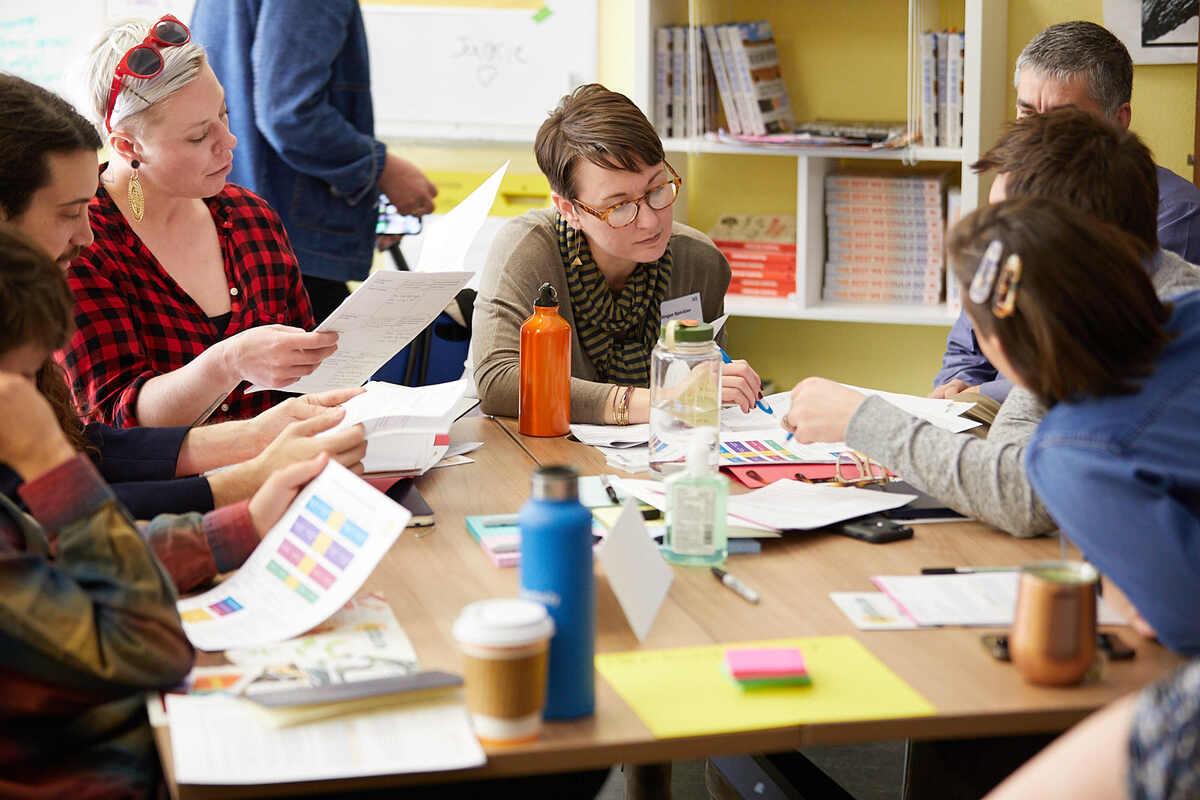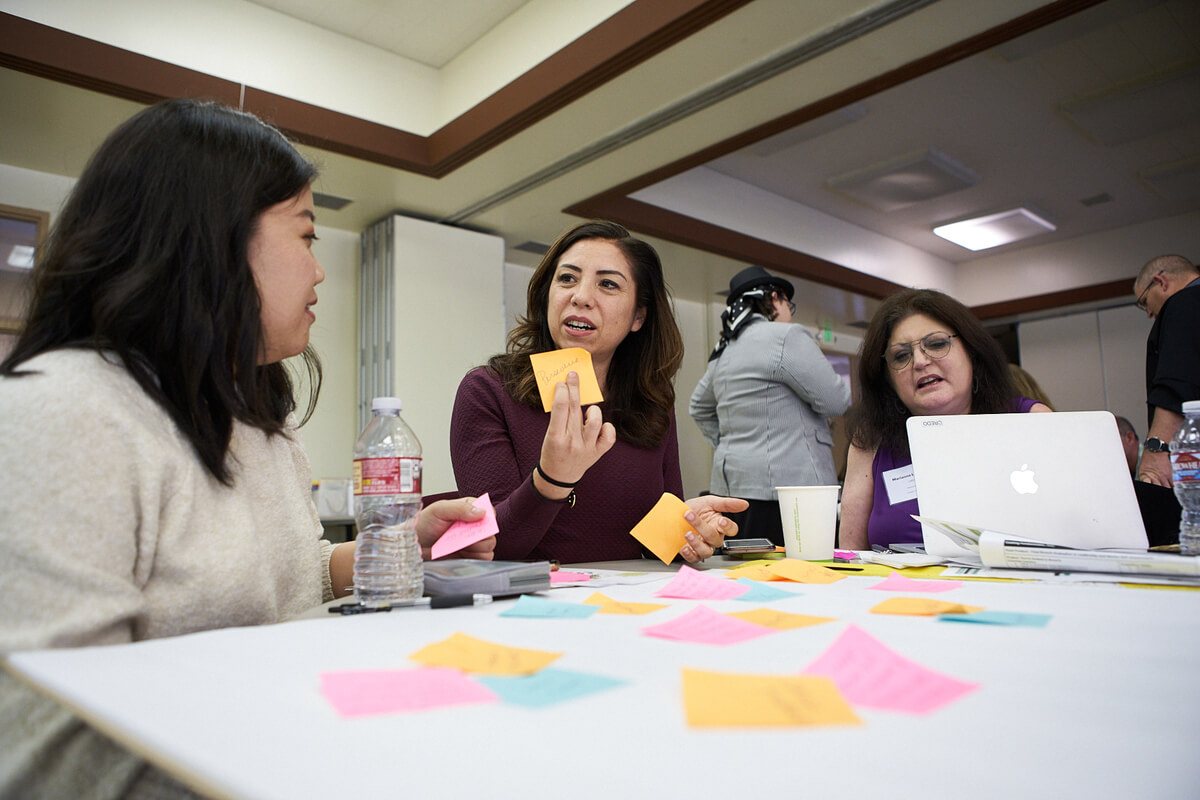How Instructional Coaching Helps Teachers Reach Their Potential
The Revere Public Schools in Massachusetts spent years working hard to reinvigorate teacher engagement. Teachers…

The Revere Public Schools in Massachusetts spent years working hard to reinvigorate teacher engagement. Teachers were given a voice in selecting their professional development and reimagining educator evaluations. But one of the most exciting changes was launching a unique program called Colleague 2 Colleague (C2C).
Through C2C, veteran teachers can apply to be relieved of their regular academic responsibilities to become consulting teachers. In this role, they partner with other teachers throughout the district to focus on a specific teaching area. At the end of their two-year term, these C2C teachers return to their classrooms, bringing new ideas and resources developed during their consulting.
While this model might be unique to Revere, any school can incorporate the time and resources for teachers to receive mentorship and professional development through instructional coaching.
As Arizona State University Education Professor Mari Koerner shared with XQ, “why don’t we have teachers teaming together?” Koerner, the Alice Wiley Snell Professor of Education and Director at the Center for the Art and Science of Teaching at ASU, has spent her career helping educators master the craft of teaching.
If we want to modernize high school, we have to rethink it—with different styles of teaching and learning, like the Learner Outcomes we foster at XQ. That means helping teachers grow their skills. Teachers are there to support students and help them reach their fullest potential. But sometimes teachers need that same kind of support, and that’s where instructional coaching comes in.
What is Instructional Coaching?
Instructional coaches are school staff who work with the adults in the building as opposed to the students. Most instructional coaches begin as teachers, and some eventually become administrators. Their job is to help teachers improve the quality of their teaching, their lessons, and ultimately the quality of education for every student. Instructional coaches are mentors and role models, sharing the latest technology, pedagogy, and best practices.
Instructional coaches help educators reach their full potential by identifying teacher needs, observing their instruction, and referring to school data for insights. As the Instructional Coaching Group recognizes, instructional coaches partner with teachers to analyze their situation, establish goals, develop teaching strategies to address those goals, and provide support throughout the process.
Most importantly, instructional coaching is not about fixing teachers. The goal is to enhance classroom instruction to improve student outcomes.
What is the goal of Instructional Coaching?
Much like coaching in sports, instructional coaching shares the common goal of bringing the best performance out of the person. This translates to supporting teachers in their daily practice to improve student learning outcomes.
According to a 2022 study published by the Research Partnership for Professional Learning, coaching is effective because it allows teachers to ask questions and receive feedback while ensuring accountability. Evidence from the study also finds that when schools promote collaboration, teacher practice and student outcomes improve.
However, the study notes that coaching is most effective when coaches can focus on working with teachers, as opposed to being distracted with other administrative duties, and when they also receive professional development of their own along with support from their administration.
Educational researcher Dr. Robert J. Marzano also points out that it is essential for coaching to be non-evaluative. Ideally, a coach should not be in a management position where they are the “boss” of a teacher. When a coach has authority over a teacher, it can make it very difficult for the teacher to feel like they can be honest about their challenges in the classroom.
Why is Instructional Coaching Beneficial for Teachers?
At XQ, ensuring all adults are part of a professional learning community is a central tenet of our Design Principles for reinventing high school. If we want students to develop their voices and engage in meaningful learning experiences, we must provide teachers with the same opportunities. That means increasing access to various systems of professional development. Allowing teachers to personalize their professional development will empower them to build their skills, enrich their practice, and grow their autonomy.
For all schools, instructional coaching can be a transformative experience for teachers and, in turn, students. According to a study from the Brookings Institution, evaluations of instructional coaching programs “show that coaching can create meaningful change in teachers’ instruction in reading, science, and math.” The study highlights how coaching can:
- Transform teacher learning
- Improve teachers’ practice and student achievement
- Increase teacher retention
- Improve school culture
In early 2022, the National Education Association surveyed teachers and found nearly 55 percent are thinking about leaving the profession. While the survey found that 67 percent of respondents identified “burnout” as a major stressor, it also foundnearly 70 percent support hiring more support staff, such as instructional coaches. Finding effective strategies to support teachers is crucial, and instructional coaches provide an opportunity..
Evidence from a meta-analysis from Harvard professor Matthew Kraft suggests that instructional coaching can be more effective than traditional professional development in creating meaningful and lasting change in teacher practices. According to a new study published by the Research Partnership for Professional Learning, written by researchers from the Harvard Graduate School of Education and Brown University, coaching and teacher collaboration are keys to effective professional development.
However, an important caveat involves the number of teachers a single coach works alongside. In his research, Kraft shows that when teachers receive instructional coaching, their instruction improves enough to lead to gains in student achievement, but the effectiveness of coaching declines as the number of teachers involved increases. If districts want as many teachers as possible to benefit from coaching, leadership must invest in recruiting and training enough effective coaches.
Of course, that’s easier said than done, and many districts face instructional coaching challenges beyond funding. Some have difficulty recruiting or staffing coaches in their area, while other districts might have dozens of locations spread across vast rural areas. However, schools can leverage technology to overcome some of these barriers. For example, teachers can record themselves teaching, then consult with a virtual coach, as researchers have found little difference in the effectiveness of online versus face-to-face coaching.

Foundations of Instructional Coaching
All instructional coaching builds on relationships. For teachers to get the most out of coaching, coaches must be empathetic and active listeners, helping guide teachers in their thinking about improving their practice. Even though administrators can give sound advice to support their teachers, there is an inherent power dynamic between administrators and teaching staff. Because instructional coaches are a support staff, they are often equal to a teacher. This solidarity makes it easier for them to share their expertise while serving as a sounding board for teachers to express their vulnerabilities and challenges in the classroom.
Coaching also differs from other types of professional development. Stephanie Affinito, a literacy teacher educator at the University at Albany, writes, “Rather than experts who train teachers in one-shot workshops removed from their classrooms, instructional coaches work alongside teachers, co-constructing knowledge as fellow readers, writers, thinkers, and learners. Successful coaching partnerships rely on trust, respect, and a willingness to learn together for the sake of students.”
What are the Different Coaching Models?
There are many instructional coaching models out there that fit different learning environments. Jim Knight has spent nearly two decades studying professional learning and instructional coaching as the director of the Kansas Coaching Project at the University of Kansas Center for Research on Learning.
Based on his work, the project’s Instructional Coaching Model builds on a three-part cycle in which the coach and teacher establish a goal, identify an appropriate teaching strategy, and then implement it—making adjustments to the strategy as needed. Knight also identifies three ways coaches can approach this style of coaching.
- Facilitative Coaching: Coaches in this model work with teachers as equals. Rather than sharing their expertise and experiences, coaches seek to unlock what a teacher already knows through empathy and asking questions. This model works best when teachers already have the knowledge they need to improve.
- Directive Coaching: In many ways, the opposite of facilitative coaching. In the directive model, the coach’s expertise is the focus of the coaching session, intending to share new knowledge with the teacher. This is a good model for teachers looking to learn exactly how to teach a proven model without making adaptations; however, it is a rigid model that can easily lead to teacher resistance.
- Dialogical Coaching: In this model, teachers and coaches create an open dialogue with one another. The coach shares their expertise similarly as they would in the directive model. Dialogical coaches share several possible strategies and encourage the teacher to choose. Coaches then work with the teacher to help implement strategies aimed at student-focused goals.
There are also two other popular models: Inquiry-Based Coaching and Student-Centered Coaching.
- Inquiry-Based Coaching: Inquiry-based, or cognitive, coaching aims at developing a teacher’s reflection skills, focusing on their emotional intelligence, non-verbal communication, and underlying beliefs. This model relies on:
- Teachers and coaches understanding student needs through observation and participation to set goals related to student challenges.
- Focusing on what teachers can do differently to improve student learning through research-backed strategies.
- The coach holding the teacher accountable.
- Student-Centered Coaching: Student-Centered coaching focuses on goals for student learning rather than fixing teachers and their practice. In this model:
- Student work is at the center of the coaching style.
- Coach and teacher are partners, working on analyzing student data to develop targeted learning goals.
As author and educational consultant Diane Sweeneysays about this model, “Student-Centered Coaching shifts the focus from ‘fixing’ teachers to collaborating with them to design instruction that targets student outcomes. It is based on a collection of core practices that keep student learning at the center of coaching conversations.”
What is the Instructional Coaching Cycle?
A major component of instructional coaching is the coaching cycle—a facilitated process in which a coach identifies areas for improvement in a teacher’s professional development.
According to NWEA, an instructional coaching cycle follows a process in which “a teacher and instructional coach work collaboratively to set an instructional or student learning goal, make a plan for supporting the goal, monitor progress toward the goal, and then reflect on how well the plan supported the goal.”
The coaching cycle typically includes several phases. The Institute of Education Sciences defines these stages as Identify, Learn, and Improve.
- Identify: Teacher and coach meet to discuss the current reality of classroom instruction, perhaps by watching a recording of the teacher instructing, then establish goals for student learning.
- Learn: The coach shares actions for implementing and monitoring the plan. The coach shares different teaching strategies, provides modeling for the teacher to observe, and helps modify their practice.
- Improve: The teacher implements the strategy. Student performance data is gathered, and the teacher and coach meet to reflect on the impacts of the strategy, making adaptations where necessary.

Instructional Coaching Strategies
Knight, who’s been studying instructional coaching at the Kansas Coaching Project for more than 20 years, has identified seven factors that can lead to successful coaching.
- The Partnership Principles: Coaches are partners with teachers, not dictators. Knight says that respectful and collaborative dialogue is the key to seeing positive changes in teachers.
- Communication Skills: Since all coaching is about conversation, effective communication skills are important for any successful coach.
- Coaches as Leaders: To be an effective coach means being an effective leader. That means a coach knows their purpose and how to use their time effectively while leading teachers with a mix of ambition and humility.
- The Impact Cycle: Each coaching situation is unique, but all coaching requires an established process to ensure teachers can set and achieve their goals.
- Data: Goals need to be measured frequently to identify where adjustments are needed, and data needs to be both relevant and supportive of those changes.
- Teaching Strategies: Coaches can’t share best practices if they don’t have a deep understanding of high-impact teaching strategies, so keeping up with the field is a major component of an instructional coach’s job.
- System Support: If teachers flourish under great coaching, great coaching happens in an environment where school leaders are intentional and disciplined about providing support for their coaches.
Additionally, there are a few simple strategies coaches should keep in mind when working with both new and veteran teachers.
- Go Slow to Go Fast: Coaches are often at the frontline of the latest innovations, technology, and research for effective teaching. But don’t let excitement for new ideas overwhelm teachers. Instead, coaches should work with teachers to identify areas where they feel most comfortable and go from there.
- Listen for the Request in the Complaint: Hearing complaints from teachers is a natural, if not disheartening, part of any coach’s job. But by listening closely, coaches might discover teachers are actually asking for help. For example, a teacher complaining that they have too much curriculum to get through in a year might need help with planning or pacing.
- Assume Positive Intentions: Negative thoughts often impact an outcome before meeting with teachers. Believing teachers are open and receptive to coaching is a simple way to start a partnership on the right foot.
- Employ Effective Listening: Active listening is a crucial skill in a coach’s toolbox. Teachers may voice complaints or frustrations and may not be looking for an immediate solution. On the other hand, a teacher may share a story about a recent lesson that went well, but coaches should resist telling them about their own similar experiences. Instead, celebrate the teacher’s accomplishment and listen to their viewpoint before asking questions or offering ideas.
Tips for Instructional Coaches
As instructional coaches begin working with teachers, building and maintaining positive relationships is crucial in forming a successful partnership. In addition to the different models of instructional coaching and the strategies listed above, here are some additional tips for coaches.
Autonomy is Central to Success: Instructional coaching expert Knight has found that honoring teacher autonomy is crucial to effective coaching. If coaches want their teachers to be engaged and motivated, those teachers require the freedom of choice about what they do. Knight’s practice builds on decades of research from psychologists Edward Deci and Richard Ryan. Their Self-Determination Theory says that people feel motivated when they:
- Are competent at what they do
- Have a large measure of control over their lives
- Are engaged in positive relationships
Accentuate the Positive: It’s easy to focus your attention on areas of improvement when coaching, but be on the lookout for moments of success to share with teachers. Highlight small shifts in a teacher’s practice that positively impacts a student in a face-to-face conversation. Share this success with administrators over email for all to see.
Learn From (and With) Veteran Teachers: Coaches need to approach working with veteran teachers with a balance of bringing new insights while also learning from their years of experience. Coaches should keep some of these tips in mind when supporting veteran teachers.
- Observe a class to see what areas a veteran teacher could benefit from support.
- Don’t go in looking to change everything.
- Learn the story behind their teaching. Instead of immediately offering changes, ask about the thinking behind their lessons.
- Engage in a conversation to learn about the veteran teacher’s life and career.
- Utilize veteran teachers as models of best practices for new teachers.
Video First-Year Teachers: New teachers benefit greatly from a chance to analyze and reflect on their teaching, and one of the best ways to do that is by watching themselves teach. Here are a few tips for using video for reflection.
- Record a first lesson as a baseline to measure changes over time.
- Pick a specific goal and identify elements to pay attention to in the video.
- Curate a collection of best-practice videos from other teachers to watch and discuss strengths.
Use Co-Teaching to Support Struggling Teachers: For many first-year teachers, losing confidence in their teaching ability can be devastating. In these cases, an instructional coach may consider a more full-scale intervention by co-teaching. Dr. Jo Lein, founder of the Teaching & Leading Initiative in Oklahoma, says that spending time in the classroom and effective modeling practices can help teachers quickly learn new skills while also:
- Reinforcing positive mindsets about students
- Reinforcing positive beliefs teachers hold about themselves
- Making explicit connections between teacher actions and student actions
Coaches should be sure to assess the exact challenge the teacher is facing to avoid any adverse outcomes amid a lesson. Lein has developed a matrix for coaches to use determined by whether a teacher has a high or low belief in themselves and a high or low belief in their students.
Further Resources
Ready to jump into instructional coaching? There are plenty of more tips for instructional coaches, including the power of praise and how mentoring can be a 2-way partnership.
And are you interested in becoming a coach yourself? Check out this Career Guide to Becoming an Instructional Coach as well as 9 Questions You’ll Be Asked at an Interview.
Photo at top by Chris Chandler









